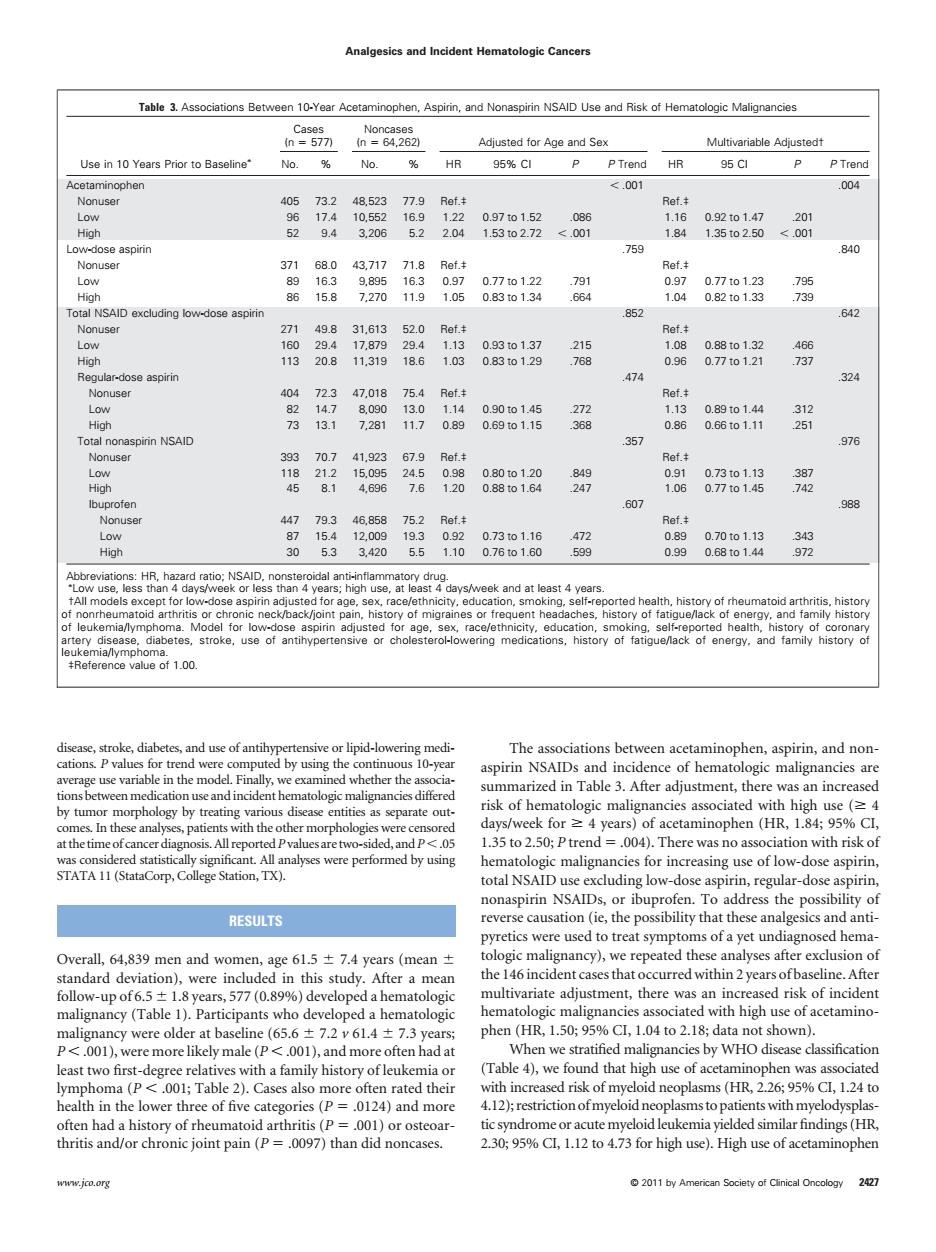正在加载图片...

Analgesics and incident Hematologic Cancers Table 3.Associations Between 10-Year Acetaminophen.Aspirin,and Nonaspirin NSAID Use and Risk of Hematologic Malgnancies Use in10 Years Prior toB No. HR 95%C P HR 95C Hiah excluding low-dose 852 642 .474 2 679 28988812 8881号 607 High atio:NSAID se asp mia/ ymphom Model or d- edi een m ogy by 5o250 L hematologic malignancies for increasing use of low-dose aspirin, total NSAID use xcluding low-dose aspirin,regular-dose aspirin RESULTS Overall.64.839 men and wo ologic malignancy),we repeated these analyses after exlusion of the 146 incident cases that occurred within 2 yearsofb a baseline(656±726L4+7.3 phen (HR,1.0%CI,1.04 to .18;data not shown). When we stratih alignancies by dassificatior Table )we 2011 by Ardisease, stroke, diabetes, and use of antihypertensive or lipid-lowering medications. P values for trend were computed by using the continuous 10-year average use variable in the model. Finally, we examined whether the associations between medication use and incident hematologic malignancies differed by tumor morphology by treating various disease entities as separate outcomes. In these analyses, patients with the other morphologies were censored at the time of cancer diagnosis. All reportedPvalues are two-sided, andP.05 was considered statistically significant. All analyses were performed by using STATA 11 (StataCorp, College Station, TX). RESULTS Overall, 64,839 men and women, age 61.5 7.4 years (mean standard deviation), were included in this study. After a mean follow-up of 6.5 1.8 years, 577 (0.89%) developed a hematologic malignancy (Table 1). Participants who developed a hematologic malignancy were older at baseline (65.6 7.2 v 61.4 7.3 years; P .001), were more likely male (P .001), and more often had at least two first-degree relatives with a family history of leukemia or lymphoma (P .001; Table 2). Cases also more often rated their health in the lower three of five categories (P .0124) and more often had a history of rheumatoid arthritis (P .001) or osteoarthritis and/or chronic joint pain (P .0097) than did noncases. The associations between acetaminophen, aspirin, and nonaspirin NSAIDs and incidence of hematologic malignancies are summarized in Table 3. After adjustment, there was an increased risk of hematologic malignancies associated with high use ( 4 days/week for 4 years) of acetaminophen (HR, 1.84; 95% CI, 1.35 to 2.50; P trend .004). There was no association with risk of hematologic malignancies for increasing use of low-dose aspirin, total NSAID use excluding low-dose aspirin, regular-dose aspirin, nonaspirin NSAIDs, or ibuprofen. To address the possibility of reverse causation (ie, the possibility that these analgesics and antipyretics were used to treat symptoms of a yet undiagnosed hematologic malignancy), we repeated these analyses after exclusion of the 146 incident cases that occurred within 2 years of baseline. After multivariate adjustment, there was an increased risk of incident hematologic malignancies associated with high use of acetaminophen (HR, 1.50; 95% CI, 1.04 to 2.18; data not shown). When we stratified malignancies by WHO disease classification (Table 4), we found that high use of acetaminophen was associated with increased risk of myeloid neoplasms (HR, 2.26; 95% CI, 1.24 to 4.12); restriction ofmyeloid neoplasms to patientswithmyelodysplastic syndrome or acute myeloid leukemia yielded similar findings (HR, 2.30; 95% CI, 1.12 to 4.73 for high use). High use of acetaminophen Table 3. Associations Between 10-Year Acetaminophen, Aspirin, and Nonaspirin NSAID Use and Risk of Hematologic Malignancies Use in 10 Years Prior to Baseline Cases (n 577) Noncases (n 64,262) Adjusted for Age and Sex Multivariable Adjusted† No. % No. % HR 95% CI P P Trend HR 95 CI P P Trend Acetaminophen .001 .004 Nonuser 405 73.2 48,523 77.9 Ref.‡ Ref.‡ Low 96 17.4 10,552 16.9 1.22 0.97 to 1.52 .086 1.16 0.92 to 1.47 .201 High 52 9.4 3,206 5.2 2.04 1.53 to 2.72 .001 1.84 1.35 to 2.50 .001 Low-dose aspirin .759 .840 Nonuser 371 68.0 43,717 71.8 Ref.‡ Ref.‡ Low 89 16.3 9,895 16.3 0.97 0.77 to 1.22 .791 0.97 0.77 to 1.23 .795 High 86 15.8 7,270 11.9 1.05 0.83 to 1.34 .664 1.04 0.82 to 1.33 .739 Total NSAID excluding low-dose aspirin .852 .642 Nonuser 271 49.8 31,613 52.0 Ref.‡ Ref.‡ Low 160 29.4 17,879 29.4 1.13 0.93 to 1.37 .215 1.08 0.88 to 1.32 .466 High 113 20.8 11,319 18.6 1.03 0.83 to 1.29 .768 0.96 0.77 to 1.21 .737 Regular-dose aspirin .474 .324 Nonuser 404 72.3 47,018 75.4 Ref.‡ Ref.‡ Low 82 14.7 8,090 13.0 1.14 0.90 to 1.45 .272 1.13 0.89 to 1.44 .312 High 73 13.1 7,281 11.7 0.89 0.69 to 1.15 .368 0.86 0.66 to 1.11 .251 Total nonaspirin NSAID .357 .976 Nonuser 393 70.7 41,923 67.9 Ref.‡ Ref.‡ Low 118 21.2 15,095 24.5 0.98 0.80 to 1.20 .849 0.91 0.73 to 1.13 .387 High 45 8.1 4,696 7.6 1.20 0.88 to 1.64 .247 1.06 0.77 to 1.45 .742 Ibuprofen .607 .988 Nonuser 447 79.3 46,858 75.2 Ref.‡ Ref.‡ Low 87 15.4 12,009 19.3 0.92 0.73 to 1.16 .472 0.89 0.70 to 1.13 .343 High 30 5.3 3,420 5.5 1.10 0.76 to 1.60 .599 0.99 0.68 to 1.44 .972 Abbreviations: HR, hazard ratio; NSAID, nonsteroidal anti-inflammatory drug. Low use, less than 4 days/week or less than 4 years; high use, at least 4 days/week and at least 4 years. †All models except for low-dose aspirin adjusted for age, sex, race/ethnicity, education, smoking, self-reported health, history of rheumatoid arthritis, history of nonrheumatoid arthritis or chronic neck/back/joint pain, history of migraines or frequent headaches, history of fatigue/lack of energy, and family history of leukemia/lymphoma. Model for low-dose aspirin adjusted for age, sex, race/ethnicity, education, smoking, self-reported health, history of coronary artery disease, diabetes, stroke, use of antihypertensive or cholesterol-lowering medications, history of fatigue/lack of energy, and family history of leukemia/lymphoma. ‡Reference value of 1.00. Analgesics and Incident Hematologic Cancers www.jco.org © 2011 by American Society of Clinical Oncology 2427������������